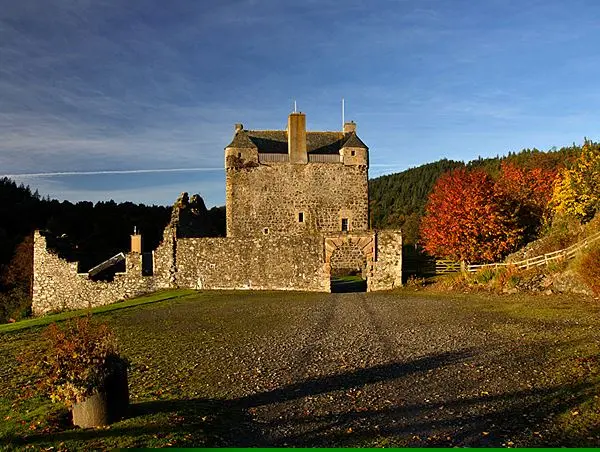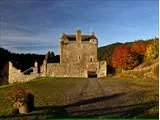Neidpath Castle - Peebles
Over 250 views on venues4hire.org

Neidpath Castle - View of the entrance



Neidpath Castle description
Castle / Wedding Venue / Funerals and Wakes / Historic Venue / Marquee Venue / Party Venue
Medium (1-150)
old photo Neidpath Castle Neidpath Castle is an L-plan rubble-built tower house, overlooking the River Tweed about 1 mile west of Peebles in the Borders of Scotland. The castle is not open to the public, except by arrangement.
History
An early castle was probably founded here by Sir Gilbert Fraser in about 1190. He already owned Oliver and Fruid Castles on the upper reaches of the Tweed. He was followed by his son Sir Simon Fraser (died 1291) and Sir Simon the Second who was executed alongside Sir William Wallace in 1307. The barony of Neidpath then passed to the Hay family, through marriage to Mary, the Fraser heiress and stayed with them until 1686. Sir William Hay (d.c.1390) probably built the present castle in the late 14th century. Sir William Hay´s grandson, also Sir William (died 1421), married the daughter and heiress of Sir Hugh Gifford of Yester, acquiring Yester Castle, which became the principal family seat, although Neidpath continued to be used. It was visited by Mary, Queen of Scots in 1563, and by her son James VI in 1587. During his visit, King James summoned Sir John Stewart of Traquair to Neidpath and persuaded him and Lord William Hay to settle a feud of some years standing.
In 1645, James Graham, First Marquess of Montrose, is thought to have taken shelter at Neidpath, after being routed at Philiphaugh and then being denied admittance at Traquair. The following year, John, Eighth Lord Hay of Yester, was created 1st Earl of Tweeddale by King Charles II. During Oliver Cromwell's invasion of Scotland in 1650, Neidpath was attacked by General Lambert in December and suffered damage to the 13th-century tower on the riverside. Some sources say that the castle was surrendered without a fight, although others suggest that it required the longest assault on any stronghold south of the River Forth to force it to surrender.
During the 1660s, the Second Earl of Tweeddale remodelled the castle, and constructed outbuidings. The Second Earl was an agricultural "improver", who planted an avenue of yews, of which one side remains. However, he was declared bankrupt, having stood surety for the sum of £24,000 for his grandfather, the Earl of Dunfermline and sold Neidpath to William Douglas, First Duke of Queensberry in 1686.
In 1693, Queensberry gave the castle to his second son William Douglas, later the First Earl of March. He married Lady Jean Hay, second daughter of the bankrupt Marquis of Tweedale. She thus continued to live in the castle that she had been partly brought up in. They also had three unmarried daughters, one of whom, Lady Jean, may have been the sorrowful „Maid of Neidpath“, concerning whom, both Sir Walter Scott and Thomas Campbell wrote verse. A son of the Laird of Tushielaw was her lover. Their son William, the Second Earl, made alterations to the castle in the 18th century. The Third Earl of March inherited the title and estates of the Duke of Queensberry in 1778, and subsequently let Neidpath to tenants. These included the philosopher and historian Adam Fergusson, with whom Sir Walter Scott spoke to William Wordsworth of having spent cheerful days at Neidpath. The Fourth Duke, William Douglas became one of the wealthiest landlords in the kingdom, but spent most of his days in London as the star of Piccadilly and was known as „Old Q“. He cared nothing for his lands and in 1795, ruthlessly cut down all the trees and demolished the beautiful hanging gardens that sloped down the castle banks to the Tweed. He was famously pilloried for this act by William Wordsworth in a sonnet written after his visit in 1803.
The castle suffered neglect and by 1790 the upper storeys of the wing had collapsed. On the death of the unmarried Fourth Duke in 1810, the castle, along with the earldom of March, was inherited by Francis Charteris, Sixth Earl of Wemyss, through his great-great-grandmother, Anna Douglas, only daughter of the First Duke of Queensberry and wife of David, Third Earl of Wemyss. The dukedom went to the Scotts of Buccleuch.
The Wemyss family have not resided in the castle, but have maintained it and improved it where possible to this day.
Venue suitability
This venue is suitable for the following uses:
Yes
Yes
Yes
Yes
Yes
Venue facilities
0 spaces
12 rectangle tables
30 chairs, 10 benches
Other venue facilities
Yes
We don't currently hold any detailed information about the rooms at this Venue.
If this is your Venue or Hall please use the Adopt link on the right to add more detailed information about this Venue.
If you wish to hire this Venue or Hall please use the contact details on the overview tab.
Please encourage every Venue to take a few minutes to 'Adopt' their listing and add unique content and photos.
